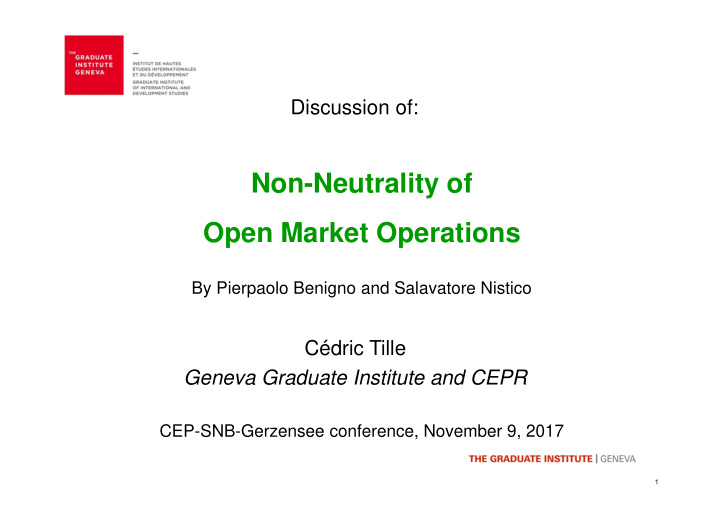



Discussion of: Non-Neutrality of Open Market Operations By Pierpaolo Benigno and Salavatore Nistico Cédric Tille Geneva Graduate Institute and CEPR CEP-SNB-Gerzensee conference, November 9, 2017 1
Should we care about central banks’ losses? Central banks have acquired large amounts of risky assets. Mortgage-backed securities at the Fed. Foreign bonds and stocks at the Swiss National Bank. Should we care if the central bank suffers losses on these? Usual answer: No, the government can recapitalize it. But what if it doesn’t do so? The paper considers the impact of losses on risky assets (default, or lower price on long assets when interest rates increase). Conditions for neutrality (no impact on inflation and output). Neutrality breaks and inflation is higher if: No treasury support (remittance never negative), including deferred asset policy. Requires large losses. Policy avoiding negative profits (financial independence). 2
Cost of central bank independence Start from a liquidity trap with a negative natural interest rate. The natural rate unexpectedly turns positive, leading to losses on long term assets. To keep profits at zero, the central bank delays the exit from ZLB. Inflation increases temporarily, them remains persistently low. 3
Comment 1: magnitudes and default shock Shocks are large: the natural rate increases by 6 percentage points (interest rate shock), default losses on risky assets are 40 or 80 % (default shock). Do smaller more realistic shocks give also generate problems for the central bank’s balance sheet? Under the default shock the loss is permanent. A loss reflecting impaired markets is more realistic. StabFund set up by the Swiss National Bank for UBS assets in 2008 generated profits (about 7 billions CHF). The central bank has time. 4
Comment 2: interest rate shock Interest rates are now increasing in the United States. Has the Fed suffered losses as the model predicts? Are losses from the interest rate shock really losses? Valuation losses, provided the central bank marks to market (the Fed does not). Not a problem if assets are held to maturity. Holding to maturity does not work for foreign reserves, as the exposure is to the exchange rate. Exchange rate moves are more likely to reverse than interest rate changes. Losses may be short-lived. 5
Comment 3: why hold risky assets? Central bank profits come from two sources. Spread between interest bearing assets and non-interest liabilities (money). Risk premium in return on risky assets. Losses can only come from holdings of risky (and long dated) assets. Why does the bank bother holding them? No role for credit easing, where the central bank would substitute for a constrained financial sector (Gertler and Karadi). In a richer model, trade-off of losses aginst benefits of CE. There should be an initial level of equity where exposure to losses is not a problem. Trade-off with cost of taxes needed to replace CB payments. 6
Comment 4: is higher inflation a problem? Losses affecting the central bank induce it to let inflation increase. This seems like a good idea as inflation remains stubbornly low in advanced economies. Losses on foreign reserves cannot be handled by «hold to maturity». Losses – and subsequent inflation – when the domestic currency appreciates. But pass-through of apprectiation to import prices lowers inflation. By how much do the two channels offset each other? If anything low inflation (after the initial burst) under the financial independence regime seems more problematic. Could financial prudence be a bad idea? 7
Comment 5: the Swiss case The SNB marks to market, and is exposed to exchange rate risk. Still, even in the crisis, it made money. SNB profits (Chf bls) 2010-2017 (bls CHF) 40 30 Profit 65 20 On FX reserves 53 10 0 On gold 4 2011 2012 2013 2014 2015 2016 2017 -10 On CHF holdings 4 -20 -30 On Stabfund 7 -40 8
Comment 6: who sets the payment to Treasury? The SNB made money, but some quarters drive the results. Large loss following the abandonment of the euro floor. Equity and reserves consist of: Share capital (Chf 25 million end 2016). Monetary policy reserve (MPR, Chf 62.8 billion end 2016). Distribution reserve (DR, Chf 20 billion). Payments to the Confederation and Cantons set on a simple rule, renewed every 5 years, with little change. Increase the MPR by 8 %. Add the remaining profits / losses to the initial DR. No payout if the DR is negative. CHF 1 billion payout (or lower if DR < 1 bls). CHF 1 billion extra if DR > 20 bls. 9
Conclusion The paper provides a rigorous analysis of the impact of losses by central banks. In the absence of fiscal backup, this can lead to temporary increases in inflation. Is this such a problem with smaller losses? Is higher inflation a problem? Providing the central bank with enough equity and reserve capital should solve the problem. And transfers can be done following simple rules. 10
Recommend
More recommend